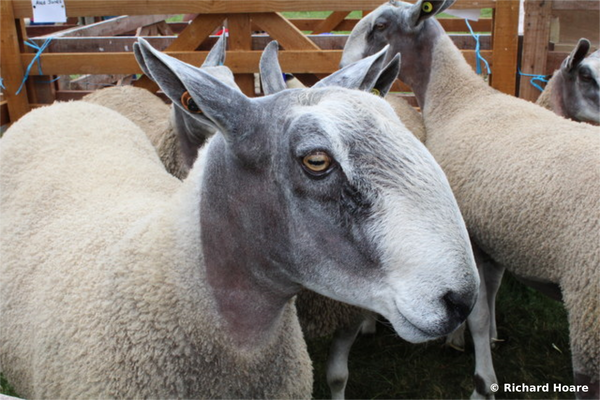Know Your Fiber: Bluefaced Leicester
Posted on March 02 2018

Named for their beautiful gray-blue skin underneath their lustrous wool, the story of Bluefaced Leicester sheep is also the story of how England contributed to a revolution in livestock breeding. Read on, and learn all about how the family tree of this amazing sheep contributed to the sheep breeding techniques we still use today!
In medieval Europe, sheep of all kinds were valued for both meat and wool, but it was long staple wool that was most sought after for making clothing, blankets, and other woolen goods. Prior to the development of Merino sheep, England was known both for the quality the wool gathered from its various long-wooled sheep and also as the primary wool-producing country in Western Europe. Although sheep have been on the British Isles since the Bronze Age, the long-wooled sheep that were popular in medieval England are thought to be descendants of sheep brought up to England by the Romans at some point during Roman rule of the British Isles in the first century C.E.
However, England wouldn’t hold on to its status as top wool-producer towards the end of the Middle Ages. Once Spain began to develop Merino sheep, they also began to replace England as the primary producer of wool in Europe. Merino wool was considered to be the superior wool, and England had no opportunity to get Merino sheep of its own to compete with Spain. As previously mentioned in our Merino Wool article, at this time in history the export of Merino sheep from Spain was punishable by death. So, what was England to do?
The answer for many English sheep farmers was to gradually shift from raising sheep mostly for wool, to raising sheep mostly for meat. While quite a lot of wool was still produced by English farmers, the primary purpose of sheep raising began to shift from wool to meat during the late Middle Ages and peaked during the 1700s. Still, dual breeds (sheep that could produce good quantities of both meat and wool) were valued, and the demand for quality English wool never completely disappeared. After all, not everyone could afford the cost of the fine Merino and other wool available from the Spanish.
While the locks of long-wooled sheep of England were still desirable, the sheep were not known for producing great quantities of meat. So, what was a person to do if they wanted an English sheep that produced both long staple wool and was also a good meat animal? The answer, if you were Robert Bakewell (1725-1795) of Dishley, Leicestershire, was to revolutionize sheep breeding. Robert Bakewell was the first to improve sheep (and cattle) for meat production through methodical and selective breeding, including inbreeding to select for desirable traits and culling to remove undesirable traits. He was so successful, that other farmers began to inquire about his techniques. Bakewell spent much of the rest of his life promoting his breeding ideas and teaching them to other farmers. Bakewell’s breeding techniques, later referred to as artificial selection, also inspired Darwin’s theory of natural selection.
Using English sheep, Robert Bakewell developed two breeds of big, long-wooled sheep – the Lincoln Longwool and the Dishley Leicester. In the 1760s, two of Bakewell’s students, Matthew and George Culley, decided to try their hand at creating a new sheep breed. They took Dishley Leicester rams and bred them with ewes from other sheep breeds to create the Border Leicester sheep breed.
With the revolutionary breeding techniques developed by Robert Bakewell, sheep breeding throughout the Western Hemisphere began to develop quickly; an explosion of new sheep breeds entered the agricultural world. However, it wasn’t until the late 1800s that the Bluefaced Leicester was developed as an entirely new breed. Breeding dark skinned, fine-wooled Border Leicester sheep with a variety of other English sheep, including the dark-blue skinned Wensleydale, the Bluefaced Leicester was originally developed to produce breeding sires intended to improve other sheep flocks.
The Bluefaced Leicester soon became quite popular beyond just their potential to improve other sheep flocks, though. Their long, lustrous locks and soft wool made them a very popular breed in England. By the early 1960s, the Bluefaced Leicester was so popular that English farmers created the Bluefaced Leicester Sheep Breeders’ Association, and published their first national flock book in 1964.
In the 1970s, the first Bluefaced Leicester sheep arrived to North America by way of Canada. It wasn’t until the early 1980s that the first Bluefaced Leicester sheep arrived from Nova Scotia to the United States. While the majority of Bluefaced Leicester sheep are still found in the U.K. today, Canadian and the United States sheep farmers are also continuing to discover the value and beauty of the Bluefaced Leicester.
Nearly all Bluefaced Leicester (also known as BFL among many fiber fans) produce white wool, although some will produce dark brown or black wool. More rarely, some Bluefaced Leicester are patterned, although this is not considered a desirable characteristic and so it is often bred out as quickly as it appears. The beautiful luster of Bluefaced Leicester provides a lovely sheen to the finished yarn, and its drape is superior to many other wools. While not quite as fine as some Merino, the 24-28 micron wool of the Bluefaced Leicester is still very soft and comfortable to wear against the skin. It also has a staple length of up to 6 inches, which makes it a dream to spin for spinners.
Come on in or shop online and explore our Bluefaced Leicester products! Huckleberry Knits Willow has a perfect sock yarn blend of 80% Bluefaced Leicester wool with 20% nylon, and our Erica Knight British Blue Wool is 100% Bluefaced Leicester. Spinners and felters, we have Bluefaced Leicester fiber for you, too. Check out all our available Bluefaced Leicester fiber and get to crafting!
Creative Commons Image License 2.0

Follow US